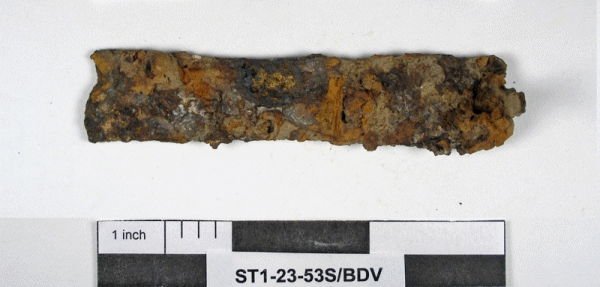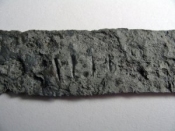Knife Blade

Conservator’s Notes
This very small iron blade was pulled from the collections and sent to the conservation laboratory for treatment. The shape of the object indicated the artifact was some sort of knife blade but no other details were visible through the corrosion layers at that time. The blade is missing the very tip, but the tang where it was originally connected to a handle remained intact. The handle would have probably been made from wood or bone, and had disappeared completely while the knife was buried in the ground for over 300 years.
 The ferrous-oxide corrosion products covering the knife upon excavation were quite dense, and contained chlorides and other non soluble salt ions. The object was surface cleaned using mechanical cleaning techniques in the conservation laboratory to remove the corrosion and ions. During cleaning, detailed markings were revealed in the metal surface of the blade. The markings do not appear to be complete and represent marks applied by a maker or owner of the object. Maker’s marks are often seen on the blade of a knife, opposite the side that is continually being re-sharpened or used the most.
The ferrous-oxide corrosion products covering the knife upon excavation were quite dense, and contained chlorides and other non soluble salt ions. The object was surface cleaned using mechanical cleaning techniques in the conservation laboratory to remove the corrosion and ions. During cleaning, detailed markings were revealed in the metal surface of the blade. The markings do not appear to be complete and represent marks applied by a maker or owner of the object. Maker’s marks are often seen on the blade of a knife, opposite the side that is continually being re-sharpened or used the most.
Marks on metal artifacts are usually unique to the individual making or using the object and are used to represent that individual. They can be simple letters or numbers, an emblem, picture or symbol, or a combination of the above. Because the lines and marks on this object appear to be scratched into the surface of the iron, the mark was probably put there by the maker or owner, but it is very difficult to tell. A close up photograph [see below] of the object reveals several vertical lines which appear to be parts of letters. Some of the markings were disrupted by corrosion and are missing. It is very rare to even find markings still remaining on iron blades such as these after being buried so long. Some maker’s marks can be traced to a person, country or city of origin and can indicate the movement of groups of people.
Maker’s marks can also be found on other types of metal artifacts, such as copper alloys, lead alloys and silver. Some examples of these include the marks and dates often found on the interior of window leads, applied by the maker of the turned leads. Evidence of maker’s marks has also been found on copper alloys at Historic St. Mary’s City. Many of these appear to be clearer than those found on the iron blade, as the surface of the copper alloys does not deteriorate in the same way as iron in the ground. For an example of a copper alloy maker’s mark please see copper alloy case studies. Note the difference in the maker’s mark revealed in a copper alloy.
Curator’s Notes
![]() Conservation often unmasks very valuable information hiding beneath a layer of corrosion. This specimen bears a series of marks where it is traditional for knife blades to have maker’s marks. This series of marks may be a maker’s mark, or it could be an owner’s identification mark. More research is needed to be sure.
Conservation often unmasks very valuable information hiding beneath a layer of corrosion. This specimen bears a series of marks where it is traditional for knife blades to have maker’s marks. This series of marks may be a maker’s mark, or it could be an owner’s identification mark. More research is needed to be sure.


